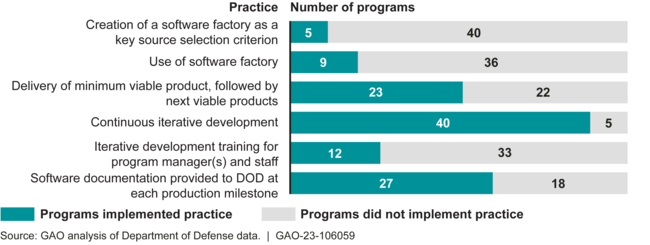Weapon Systems Annual Assessment: Programs Are Not Consistently Implementing Practices That Can Help Accelerate Acquisitions
Fast Facts
This is our 21st annual assessment of DOD's weapon systems acquisition. We found that delivery of weapon systems continues to take longer than planned—affecting DOD's ability to meet threats. Supplier, software, and design problems drove these delays.
We recommended that DOD update its policy on "modular open systems design"—an approach that helps DOD keep pace with advances in technology by allowing it to add or replace components once a weapon system is in the field. Weapon programs don't consistently verify that their approaches work as intended.
Weapon systems acquisition is on our High Risk List.
The Army’s Integrated Visual Augmentation System

Highlights

What GAO Found
The Department of Defense (DOD) continues to face challenges quickly developing innovative new weapons. These challenges persist even with recent reforms to its acquisition process intended to help deliver systems to the warfighter in a timelier manner.
Major defense acquisition programs. From DOD's 2020 submission of reports on their major defense acquisition programs to 2022, the number of these programs declined. However, the portfolio's total cost increased, and the average planned cycle time to deliver operational capabilities shows new delays. DOD did not produce these reports in 2021 due to the lack of future year funding data in the fiscal year 2022 budget request.
Major Defense Acquisition Programs Are Taking Longer to Deliver Capabilities

Over half of the 26 major defense acquisition programs GAO assessed that had yet to deliver operational capability reported new delays. Driving factors included supplier disruptions, software development delays, and quality control deficiencies. Additionally, these programs continue to make investment decisions without sufficient knowledge, which can increase the risk of delays. Net costs for the 32 major defense acquisition programs that GAO assessed both this year and last year increased by $37 billion. Rising modernization costs, production inefficiencies, and supply chain challenges drove the majority of costs.
Middle tier of acquisition (MTA) programs. Two MTA efforts transitioned to become major defense acquisition programs since GAO's last assessment and could begin delivering capabilities soon. However, other MTA efforts' schedule delays and lack of progress in maturing technologies raise questions about MTA programs' overall ability to deliver capabilities more quickly.
Of the 16 rapid prototyping efforts included in both GAO's current and prior assessments, six have delayed planned operational demonstrations by at least 12 months. The later that demonstrations occur during the MTA effort, the less time programs will have to address emerging issues. This delay heightens the chance that programs will transition with more technical risk.
Software development approaches and cybersecurity practices. Programs reporting use of modern software development approaches increased over the past year from 43 of 59 programs (73 percent) to 45 of 58 programs (78 percent). But, programs reported limited implementation of the Defense Science Board's recommended practices to accelerate software development.
Programs Report Limited Implementation of the Defense Science Board's Recommended Practices to Accelerate Software Development (out of 45 programs)

GAO also observed mixed progress in cybersecurity planning. All programs had or planned to have a cybersecurity strategy. But, programs did not consistently report scheduling cybersecurity test events in time to inform key milestones. Without timely cybersecurity testing, programs are at greater risk of delays if issues are discovered later in development.
Key product development principles. GAO found that some—but not all—MTA and future programs used certain product development practices aligned with key product development principles employed by leading companies to deliver innovative capabilities quickly. Examples reported by programs included practices such as using 3D modeling and printing to help design and test products, and holding regular user testing events to obtain feedback. GAO has ongoing work to define associated metrics to help inform future assessments.
Modular open systems approach. Most programs GAO reviewed reported using a modular open systems approach. But they did not consistently report planning to verify successful implementation of the approach before key points in the acquisition process, such as before beginning production. A modular open systems approach enables weapon programs to better respond to changing threats, in part, by allowing them to more easily add, remove, and replace components over the system's life cycle.
More than Half of Major Defense Acquisition Programs Using a Modular Open Systems Approach Do Not Report Plans to Verify Conformance before Production

Neither DOD systems engineering policy nor modular open systems approach guidance specifically addresses when programs should complete or document verification testing. Ensuring that any new guidance and updates to relevant policies address when programs should conduct verification testing and document planning could help DOD ensure its systems can incorporate innovative technologies over time to remain responsive to emerging threats.
Why GAO Did This Study
In 2020, in an effort to deliver more timely and effective solutions to the warfighter, DOD revamped its department-wide acquisition policies. These policy changes responded to statutory provisions and long-standing concerns from some members of Congress that the defense acquisition process was overly bureaucratic and too slow.
As part of these changes, DOD established the Adaptive Acquisition Framework, which has a variety of pathways for acquisition programs. This framework includes the major capability acquisition pathway to acquire and modernize DOD programs that provide enduring capability, including major defense acquisition programs, and the middle tier of acquisition pathway for rapid prototyping and rapid fielding.
This report, GAO's 21st annual assessment, responds to a statutory provision for GAO to review selected DOD acquisition programs and efforts.
This report assesses the characteristics and performance of 101 of DOD's costliest weapon programs (75 major defense acquisition programs, 19 MTA programs, and 7 future major weapon acquisitions); and selected programs' implementation of leading acquisition practices and principles, modern software development approaches, and cybersecurity practices.
Additionally, the report describes recent legislative, organizational, and policy changes pertaining to modular open systems approaches; and the extent to which selected programs reported implementing a modular open systems approach.
GAO identified programs for review based on cost and acquisition status; reviewed relevant legislation and policy; collected program documents; used a questionnaire to obtain data from program offices; and interviewed DOD officials.
Recommendations
GAO recommends that DOD ensure that any new guidance and updates to relevant policies include details on when programs using a modular open systems approach should complete verification testing and how they should document planning. DOD concurred with the recommendation.
Recommendations for Executive Action
| Agency Affected | Recommendation | Status |
|---|---|---|
| Department of Defense | The Secretary of Defense should ensure that the Under Secretary of Defense for Research and Engineering and the Under Secretary of Defense for Acquisition and Sustainment include the appropriate times during an acquisition program's development for programs using AAF pathways to complete MOSA verification testing and how plans for conducting that testing should be documented in new guidance and updates to relevant DOD policies. (Recommendation 1) |
DOD concurred with this recommendation. In August 2023, officials from the Offices of the Under Secretary of Defense for Acquisition and Sustainment and the Under Secretary of Defense for Research and Engineering reported they would engage with officials from the Office of Developmental Test, Evaluation, and Assessments; Office of the Director, Operational Test and Evaluation; the military services; and other stakeholders to identify the documentation that needs to be updated to develop a schedule for MOSA verification testing during an acquisition program's development. In July 2025, DOD officials stated that policies and guidance are still in the process of being updated and that updates are expected to be complete by December 2026.
|
